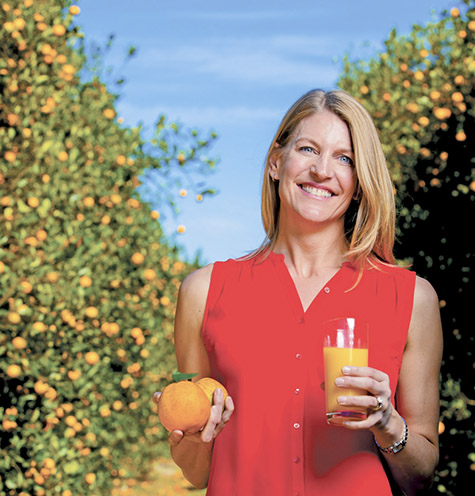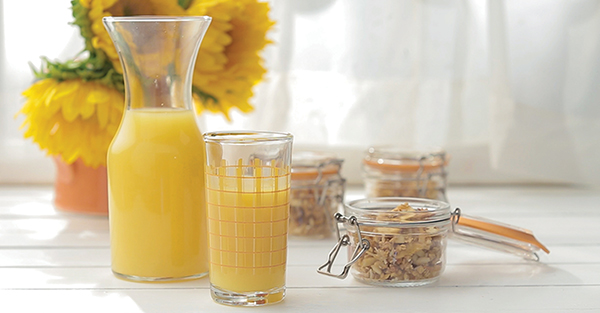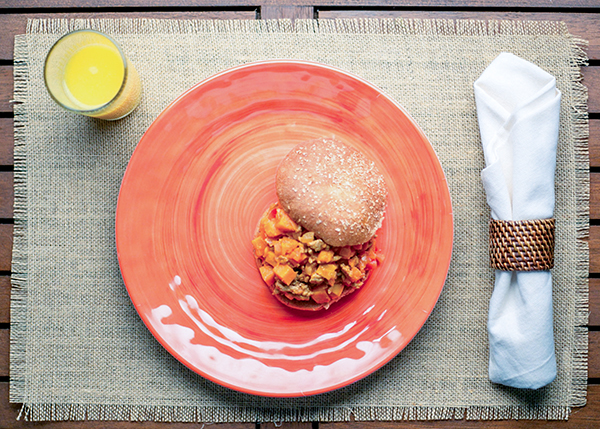Level Up Brunch Spreads with Natural Sweetness
(Family Features) Breezy spring days can lead you on nearly any adventure, and they can happen in your own backyard, on a short road trip or during a full-blown beach vacation. No matter where you are when those warmer days arrive, you can put outdoor meals on the menu and take advantage of perfect opportunities for fresh brunch spreads to share with loved ones.
Whether you’re enjoying spring sunshine at home or traveling with friends and family, Florida Orange Juice can be a delicious, nutritious addition to your outdoor plans. By delivering a powerful combination of vitamins, minerals and phytonutrients that have associated health benefits, it’s perfect for supporting healthy immune systems and overall health.
With no added sugar, 100% orange juice comes coupled with essential nutrients like vitamin C, potassium, folate and thiamin. Orange juice is one of nature’s nutrient-rich foods, and it can serve as a substitution for sugar-sweetened beverages in the diets of both children and adults while providing a convenient way to complement whole fruit intake to help reach one’s daily fruit intake recommendations.
As an ultimate go-to beverage and ingredient, Florida Orange Juice is convenient and versatile for use in breakfast recipes like these Orange Juice Biscuits or cocktails such as Orange Juice Spicy Margaritas. These naturally sweet, tasty recipes make for ideal additions to brunch menus all spring long.
“Families across the country are planning spring vacations and springtime brunches, so it’s an important time to think about wellness and immune health,” said Dr. Rosa Walsh, director of scientific research at the Florida Department of Citrus. “As the ultimate drink for spring, 100% orange juice is a healthy option while on the go and it’s easy to add into almost any recipe. It’s rich in vitamin C and includes other nutrients like potassium, folate and thiamin, making it a great choice for overall wellness.”
To find more ways to enhance spring brunches, visit FloridaJuice.com.

Orange Juice Biscuits
Orange Butter Sauce:
- 1 1/2 cups Florida Orange Juice
- 2 1/2 tablespoons unsalted butter
Orange Biscuits:
- 1 1/2 tablespoons granulated sugar
- 2 teaspoons grated orange zest
- 2 cups bleached all-purpose flour, plus additional for kneading
- 1 2/3 tablespoons baking powder
- 3/4 teaspoon salt
- 1/2 cup shortening
- 1/2 cup whole milk
- 1/4 cup Florida Orange Juice
- To make orange butter sauce: Boil orange juice 5 minutes, or until reduced by half. Add butter and stir until melted. Remove from heat.
- To make orange biscuits: Preheat oven to 425 F.
- Use fingers to rub sugar and zest together until sugar is moistened and looks like wet sand.
- In large bowl, whisk orange sugar, 2 cups flour, baking powder and salt. Using two forks or pastry blender, cut in shortening to size of small peas.
- Combine milk and orange juice then stir into flour mixture to make sticky dough.
- Turn out dough onto well-floured work surface. Sprinkle top with flour and knead about six times while folding dough over in half and using more flour as needed.
- Pat dough out to 3/4-inch thickness. Cut out biscuits with round cutter by dipping cutter in flour then pressing into dough. Do not turn cutter while pressing.
- Place biscuits close together but not touching on baking sheet.
- Gather dough scraps and fold 2-3 times, pat out again and cut biscuits. Repeat until dough is used.
- Brush tops with orange butter sauce. Bake 15-20 minutes, or until lightly browned.
- Serve warm or at room temperature with remaining sauce.

Orange Juice Spicy Margaritas
- 2 cups Florida Orange Juice
- ice
- 2 cups simple syrup
- 8 ounces silver tequila
- 2 ounces triple sec or orange liqueur
- 2 ounces lime juice
- 4 ounces seltzer
- ghost pepper salt, to taste
- 4 Florida Orange slices, 1/4-inch thick
- In saucepan over medium heat, reduce orange juice to 1 cup and allow to cool.
- Fill cocktail shaker 3/4 full with ice. Add orange juice reduction, simple syrup, tequila, triple sec and lime juice.
- Shake and pour into four glasses. Top each glass with 1 ounce seltzer.
- Pour ghost pepper salt onto saucer and dip edges of orange slices in ghost pepper salt. Place orange slices on rim of each glass, if desired.
Source: Florida Department of Citrus
Natural v. Added Sugars
What does it mean for your family’s health?
(Family Features) Sugars are one of the most important health conversations today. A diet filled with too many added sugars is associated with weight gain, type 2 diabetes and heart disease. According to the 2005-2010 National Health and Nutrition Examination Survey, the average American consumes an average of 20 teaspoons a day, significantly more than the 6-9 teaspoons recommended daily by the American Heart Association.
Sugar can mean different things to different people, which not only adds to the confusion, but can quickly derail even your best intentions as you try to make the right choices for your family.
The difference between added and naturally occurring sugars
Many nourishing foods such as fruits, vegetables, certain whole grains and dairy products contain what are known as naturally occurring sugars; these are simple carbohydrates that are naturally present in a food’s biological structure. For example, the lactose found in milk is a sugar, as is the fructose in fruit.
In contrast, added sugars are those sugars or sweeteners you add in your kitchen – adding sugar or honey to a recipe or onto your breakfast cereal, for example – as well as sugars and sweeteners that are added to a variety of products by food manufacturers. Added sugars are often used to enhance taste and flavor, of course, but can also be included for other reasons, such as to prevent spoiling – think summer jams – or assist in fermentation, such as in baking.

“Working with the Florida Department of Citrus, I’ve seen firsthand how much confusion there is around this topic for many families,” said registered dietitian Kate Geagan, author of “Go Green Get Lean.” “Yet while too many added sugars can fill your diet with ‘empty calories,’ naturally occurring sugars are found in some of nature’s most nutrient-rich packages, delivering a bevy of benefits such as vitamins, minerals, antioxidants and more.”
An 8-ounce glass of 100 percent orange juice, for instance, has no added sugar. Beyond being an excellent source of vitamin C, it’s a good source of folate, especially important for women of childbearing age, as well as potassium, a vital mineral which helps nerves and muscles communicate and can help offset the effects of too much sodium in the diet. In fact, the FDA recently announced it will add potassium to the Nutrition Facts Panel because many Americans are falling short.
The benefits don’t stop there, though. A glass of 100 percent orange juice also delivers magnesium, vitamin A and niacin. Plus, it’s a significant source of hesperidin, an antioxidant that research suggests may have heart, blood pressure and cognition benefits, as well as reduce inflammation and oxidation. Furthermore, one glass counts as one serving (1 cup) of fruit to help you meet the 1.5-2 cups per day recommended by the Dietary Guidelines for Americans.
How much added sugar is too much?
A delicious, vibrant eating plan that you can stick with for the long haul doesn’t mean you can’t ever consume added sugar, but it is about cutting back for most Americans – especially for groups with the highest intakes, such as adolescents and men – and replacing those calories with nutrient-rich foods.
The most recent Dietary Guidelines for Americans recommend limiting added sugar intake to a maximum of 10 percent of total calories each day, or 200 calories of a 2,000 calorie diet, which matches guidelines from the World Health Organization and the American Heart Association.
Clearing up food label confusion
In May 2016, the FDA announced a revamped Nutrition Facts Panel that includes, among other improvements, clearly listing added sugars on their own line for the first time.
Up until now, both added and naturally occurring sugars have been lumped together under one “sugars” line, making it vexing for the average eater to determine how much sugar is naturally occurring versus added, especially given the dozens of different names for sweeteners that manufacturers often use. When this change hits supermarket shelves, families will be able to more easily spot foods and beverages that contain little to no added sugar.
In addition to highlighting added sugars and potassium, the Nutrition Facts Panel will now more accurately reflect serving sizes that Americans actually eat and drink. Also, packages that are reasonably consumed in a single sitting will no longer get a free ride using smaller serving sizes and listing multiple “servings” per bag, container or can.
For best results, focus on filling your diet with an abundance of naturally nutrient-rich foods and shift to a diet that includes plenty of plant foods. For more recipes using Florida orange juice, visit floridacitrus.org.

Homemade Orange Granola
Servings: 6
- 1 1/2 cups quick cooking oatmeal
- 1 cup chopped walnuts
- 1/2 cup sliced almonds
- 1/4 cup sunflower seeds or pumpkin seeds
- 1 1/2 teaspoons cinnamon
- 1 cup 100 percent Florida orange juice, divided
- 3 tablespoons canola oil
- 2 tablespoons honey
- 1 1/2 teaspoons vanilla extract
- 1/2 cup dried cranberries
- Heat oven to 325°F. Spray baking sheet with non-stick cooking spray.
- In large bowl, combine oatmeal, walnuts, almonds, sunflower seeds and cinnamon; mix well. Drizzle in 1/3 cup orange juice; stir well to evenly coat oatmeal mixture.
- Repeat twice more, stirring after each addition of orange juice.
- In small bowl, combine oil, honey and vanilla; stir well to combine. Drizzle oil mixture over oatmeal mixture; stir well to coat oatmeal mixture.
- Spread oatmeal mixture on prepared baking sheet in even layer. Bake 30 minutes, stirring every 10 minutes, to evenly brown granola.
- Remove from oven, add cranberries and cool completely. Store in airtight container up to one week.
Serving suggestion: For a morning parfait, serve homemade orange granola with milk or a dollop of plain Greek yogurt. Add in sliced fruit for extra color.

Sloppy O Joes
Servings: 4
- 9 ounces lean ground turkey
- 1/2 large minced onion
- 1 small red bell pepper, minced
- 1 teaspoon cumin seed, ground
- 1 teaspoon coriander seed, ground
- 1 cup Florida orange juice
- 1 cup organic tomato juice
- 1 large sweet potato, baked and diced
- 4 whole wheat dinner rolls
- In medium saute pan, saute ground turkey over medium heat until cooked thoroughly. Remove turkey; reserve.
- Saute onion until translucent. Add red pepper, cumin and coriander; saute for 1 minute then add orange juice. Cook until orange juice is reduced by two-thirds; add tomato juice and cooked turkey.
- Cook until tomato juice has reduced by two-thirds then add diced baked sweet potato and stir until combined.
- Split dinner rolls in half; spoon turkey mixture in center. Serve immediately.
Source: Florida Department of Citrus


